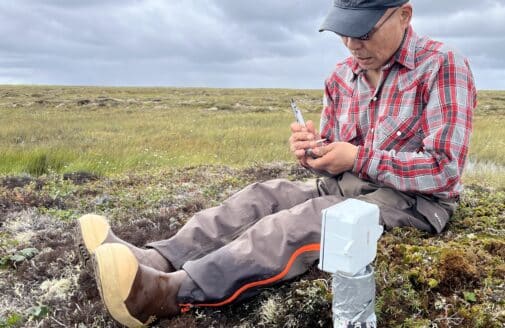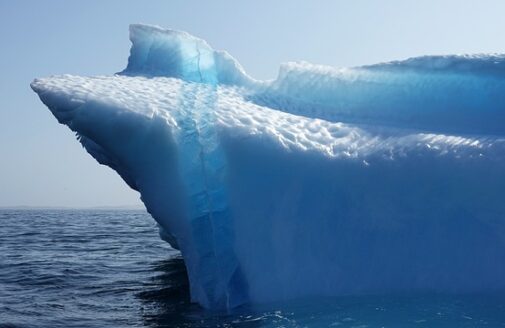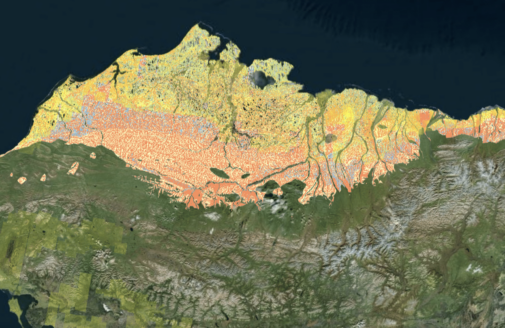Dr. Jennifer Francis testifies before the Senate Commerce, Science, and Technology Committee
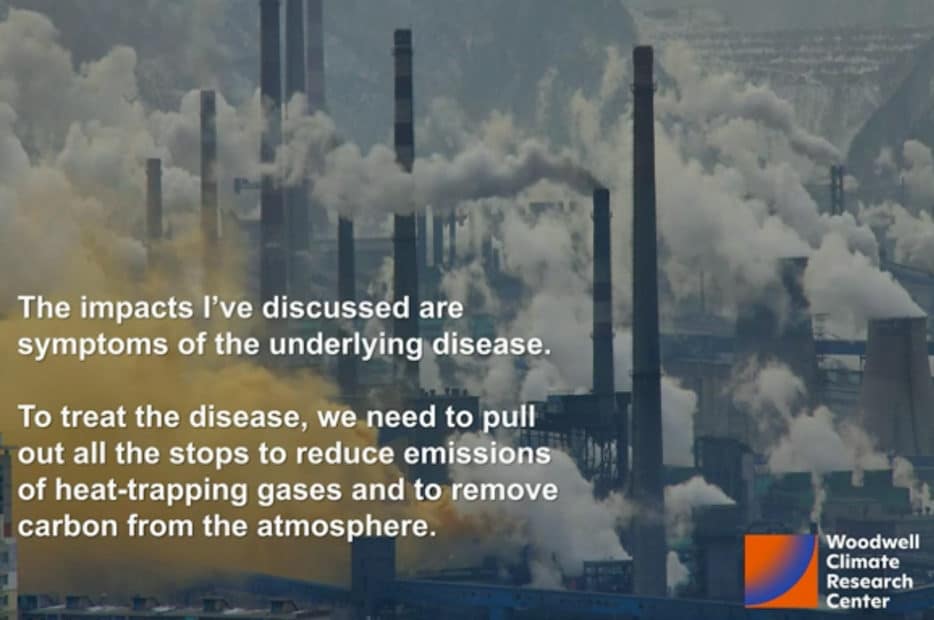
Above: A slide from the testimony by Dr. Francis.
Dr. Jennifer Francis testified on December 8, 2020 during the Security Subcommittee Hearing on Coast Guard Capabilities for Arctic Security given to the Senate Commerce, Science, and Technology Committee.
Below is the transcript of her remarks.
Testimony to the Senate Commerce, Science, and Technology Committee
Security Subcommittee Hearing on Coast Guard Capabilities for Arctic Security
Dr. Jennifer Francis
Senior Scientist – Woodwell Climate Research Center
December 8, 2020
Thank you to the committee and in particular to Senator Markey for inviting me to provide testimony for this hearing.
The Woodwell Climate Research Center is a Massachusetts-based non-profit organization of researchers who work with a worldwide network of partners to understand and combat climate change1. Our scientists helped to launch the United Nations Framework Convention on Climate Change in 1992, and shared the Nobel Prize with the Intergovernmental Panel on Climate Change in 2007. Woodwell brings together cutting edge science, and 35 years of policy impact to find societal-scale solutions that can be put into immediate action. Our scientific expertise is on climate change impacts, natural climate solutions, and climate risk. This includes work with extensive research on the local, regional, and global impacts of the rapidly warming Arctic.
I am a senior scientist and a member of the Arctic Program at Woodwell. I received my PhD in Atmospheric Sciences from the University of Washington in 1994. After 24 years as a research professor in the Department of Marine and Coastal Sciences at Rutgers University, I joined Woodwell in 2018. My research focuses on connections between climate change and the rising frequency of extreme weather events, particularly the role of rapid warming and melting in the Arctic.
Fossil fuel combustion and deforestation release heat-trapping greenhouse gases, which in turn, have caused global average temperature to rise at unprecedented rates. From 1901-2019, the globe has already warmed by 1°C (1.8°F), with nine of the top ten warmest occurring since 20052. The rate of warming is not attributable to natural causes; in fact, the globe would be in a cooling phase now if it were not for the effects of human activities. The responses of Earth’s natural systems to the warming are already adversely affecting our quality of life, and these impacts will worsen for generations to come if emissions of heat-trapping gases are not curtailed severely and rapidly. Mitigating, understanding, and preparing for these impacts is critical, hence the vital importance of hearings like this one.
The effects of rapid Arctic change on the frequency and severity of physical hazards will affect society in all regions of the world, but none more so than in the Arctic.

Above (Figure 1): Arctic temperature anomalies from 1959-2019. Data processed by Stefano Potter, and map created by Greg Fiske.
The pace of change in the Arctic system has been nothing short of staggering; the Arctic is experiencing the greater increase in average surface temperature globally (Fig 1). In just the past 40 years, half of the ice floating on the Arctic Ocean has vanished during summer3. Ice volume has declined by a whopping 75% (Fig. 2). Indeed, the dramatic loss of Arctic sea ice is the primary reason for the recent intense focus on the Arctic region. You can think of this ice as the Earth’s mirror: it reflects most of the sun’s energy that hits it right back to space without entering the climate system. Losing so much of this mirror is literally a threat multiplier to our national security in several direct and indirect ways that are distinct from those related to military concerns.
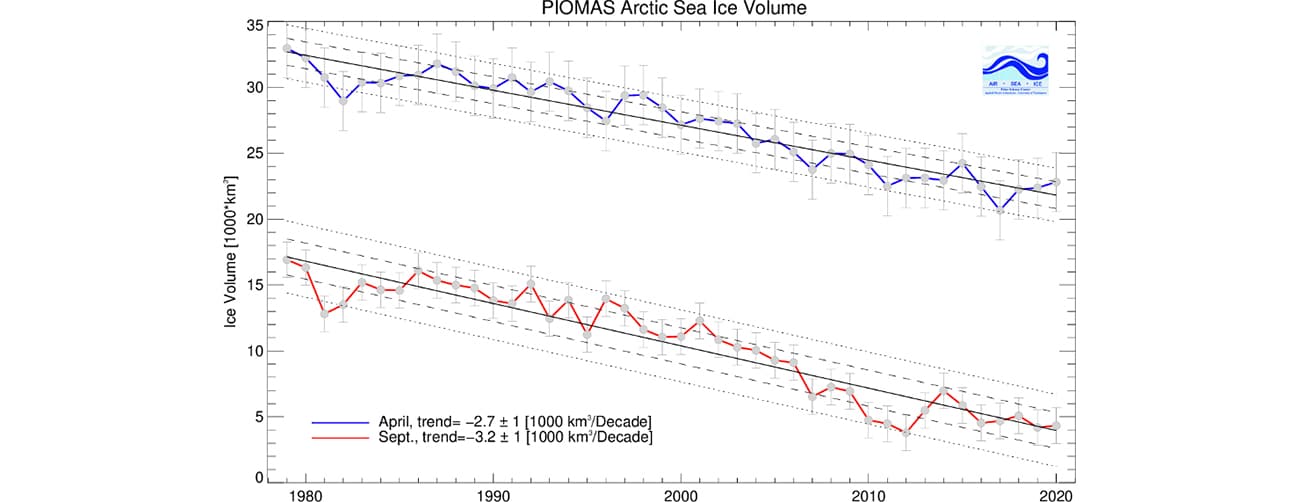
Above (Figure 2): Change in the volume of Arctic sea ice during April and September 1979-2020. From U. of Washington’s Polar Science Center4
The most direct impact of ice loss is the escalation of global warming. The extra heat now being absorbed by the planet where ice used to exist has intensified global warming by 25-40%5. The implications of this are sobering. This year alone, we’ve all watched in horror as a record number of $1 billion disasters6—including wildfires, heatwaves, floods, and rapidly intensifying hurricanes—devastated parts of the U.S. and elsewhere, threatening the security of affected communities, straining agriculture and food security, and stretching relief resources. This, Senators, is the face of global warming.
The ice loss is also causing the Arctic to warm three times faster than the Earth as a whole. This is exacerbating the melt of glaciers and the Greenland ice sheet, which contributes directly to the recent acceleration of sea-level rise, threatening coastal cities and infrastructure world-wide7. The rapid warming is also hastening the pace of permafrost thaw—frozen Arctic soils—which could release vast stores of additional fossil carbon into the atmosphere8. Arctic warming also affects the frequency and intensity of extreme weather events, as the north-to-south difference in air temperature is a major factor controlling weather patterns. Recent research, including my own, suggests that a reduction in that temperature difference will make weather systems more persistent, which can lead to prolonged droughts, heatwaves, storminess, and even cold spells9. As we all have witnessed, these tendencies have emerged in spades. Disrupted weather patterns pose new challenges to farmers and food security, electric utilities, drinking water managers, and even human survival.
The Peoples of the North are also being directly affected by their transformed surroundings. Traditional hunting is their primary source of food, and the loss of ice as a hunting platform has thrown their way of life into chaos. The species they usually hunt have shifted migration patterns or disappeared altogether, and sub-Arctic animals have appeared well north of their typical ranges. Sea ice serves as a major transportation resource, as well, but now it is often too thin to be trusted. Moreover, their coastal villages are being washed into the sea by large storm waves, as winds now blow over open ocean rather than over stable sea ice. Their roads and airstrips are buckling as the ground beneath them thaws and collapses. These impacts are undermining the security of Arctic communities in Alaska and around the hemisphere.
The news is not all bad, however. Expanded areas of ice-free Arctic waters enable normal cargo vessels to short-cut passages between major commercial ports in Eurasia and North America. Natural resources that have been inaccessible under the ice can now be more easily and economically exploited. But with this easier access also come heightened risks to those venturing into an Arctic Ocean with little in the way of infrastructure, emergency facilities, accident mitigation resources, or even ports of call. In collaboration with Tufts University, Woodwell scientists have charted more than 122 million messages from satellite Automatic Identification System (AIS) data, mapping Arctic ship traffic from 2009 to 2016 (Fig 3). The mean center of ship traffic has moved 300 km to the north and east, taking advantage of newly ice-free ocean. Change has come quickly, and the region is woefully unprepared for these new activities.
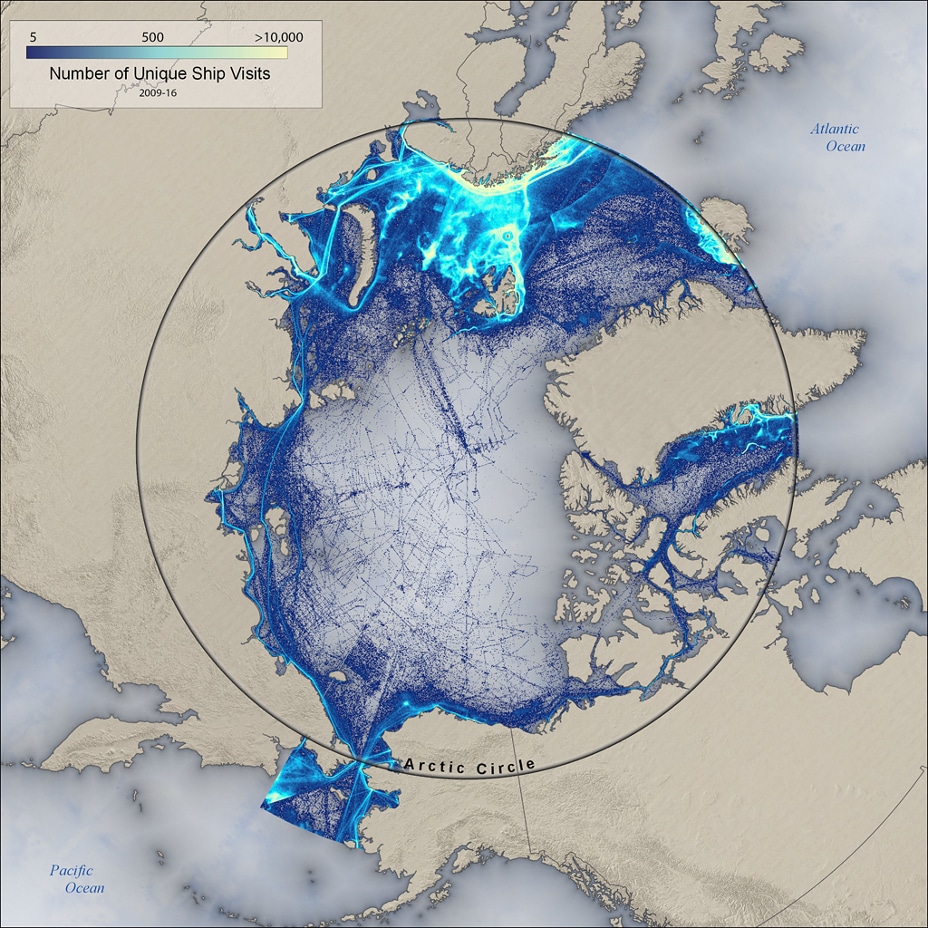
Above (Figure 3): Arctic ship traffic from 2009-2016 using AIS data. Map created by Greg Fiske.
What can we do about these threats to national security posed by Arctic ice loss and warming? The impacts I’ve discussed are symptoms of the underlying disease. To treat the disease, we need to pull out all the stops to reduce emissions of heat-trapping gases and to remove carbon from the atmosphere via natural (such as reforestation) and technological (carbon capture) means.
The symptoms must be addressed by proactively building resiliency, which depends on research that characterizes the physical threats, identifies the specific risks, and develops strategies to protect those in harm’s way. My colleagues at Woodwell are engaged in an assessment of risk owing to Arctic change, a collaboration with partners at The Center for Climate and Security (CSS). The CSS is a Washington DC-based non-partisan institute housed in the Council on Strategic Risks. That project is employing cutting-edge climate-risk modeling to understand how climate change impacts will play out in the region, and how those will affect the existing balance of security. The project will demonstrate the potential value of granular modeling of climate change impacts to anticipate and prepare for societal instability and security challenges.
Mitigating and adapting to climate change in the Arctic will not be easy or cheap, but the reactive approach will be much more expensive and threatening to national security10,11.





